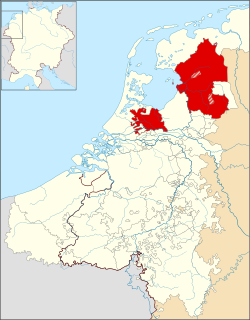
The Bishopric of Utrecht (1024–1528) was an ecclesiastical principality of the Holy Roman Empire in the Low Countries, in the present-day Netherlands. From 1024 to 1528, as one of the prince-bishoprics of the Holy Roman Empire, it was ruled by the bishops of Utrecht. The Prince-Bishopric of Utrecht must not be confused with the Diocese of Utrecht, which extended beyond the Prince-Bishopric and over which the bishop exercised spiritual authority.
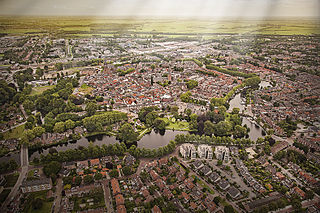
Woerden is a city and a municipality in central Netherlands. Due to its central location between Amsterdam, Rotterdam, The Hague, and Utrecht, and the fact that it has rail and road connections to those cities, it is a popular town for commuters who work in those cities.

Beverwijk is a municipality and a city in the Netherlands, in the province of North Holland. The town is located about 20 kilometres (12 mi) northwest of Amsterdam in the Randstad metropolitan area, north of the North Sea Canal very close to the North Sea coast. A railway tunnel and two motorway tunnels cross the canal between Beverwijk and the nearby city of Haarlem on the south bank.

Floris V reigned as Count of Holland and Zeeland from 1256 until 1296. His life was documented in detail in the Rijmkroniek by Melis Stoke, his chronicler. He is credited with a mostly peaceful reign, modernizing administration, policies beneficial to trade, generally acting in the interests of his peasants at the expense of nobility, and reclaiming land from the sea. His dramatic murder, engineered by King Edward I of England and Guy, Count of Flanders, made him a hero in Holland.

Adelaide of Holland, Countess of Hainaut, was a Dutch regent. She was a daughter of Floris IV, Count of Holland and Matilda of Brabant. She was also a sister of William II, Count of Holland and King of Germany. She acted as regent for her nephew Count Floris V during his minority.

John I was Count of Holland and son of Count Floris V. John inherited the county in 1296 after the murder of his father.

The Amstel is a river in the province of North Holland in the Netherlands. It flows from the Aarkanaal and Drecht in Nieuwveen northwards, passing Uithoorn, Amstelveen, and Ouderkerk aan de Amstel, to the IJ in Amsterdam. Annually, the river is the location of the Liberation Day concert, Head of the River Amstel rowing match, and the Amsterdam Gay Pride boat parade.

Muiden Castle is a castle in the Netherlands, located at the mouth of the Vecht river, some 15 kilometers southeast of Amsterdam, in Muiden, where it flows into what used to be the Zuiderzee. It is one of the better known castles in the Netherlands and featured in many television shows set in the Middle Ages.
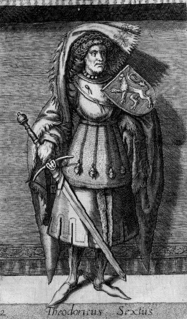
Dirk VI was Count of Holland between 1121 and 1157, at first, during his minority, under the regency of his mother Petronilla. He was the son of Count Floris II. After his death he was succeeded by his eldest son Floris III. He married Sofie of Salm, Countess of Rheineck and Bentheim. She was heiress of Bentheim, which she ruled together with her husband and which was inherited by the couple's second son Otto after his parents' death.
Floris IV was the count of Holland from 1222 to 1234. He was born in The Hague, a son of William I of Holland and his first wife, Adelaide of Guelders.

Gijsbrecht van Aemstel is a 17th-century history play by Joost van den Vondel, written to inaugurate Amsterdam's first city theatre. The first production was planned to take place on 26 December 1637, but was postponed until 3 January 1638. The piece was then performed annually in Amsterdam until 1968.

Gijsbrecht IV of Amstel or Gijsbrecht IV van Amstel was a powerful lord in the medieval County of Holland and a member of the Van Aemstel family. His territory was Amstelland, and his son was Jan I of Amstel.

The van Amstel family was an influential dynasty in the medieval Netherlands from the twelfth until the fourteenth century. The family developed the Amstelland and held the stewardship in the ecclesiastical districts in the northwest of the Nedersticht of Utrecht, first in the name of the bishop of Utrecht and later the count of Holland.
William II Berthout of Mechelen was bishop of Utrecht from 1296 to 1301, succeeding Jan II van Sierck. He was a leader of the Berthout family, which ruled over the Heerlijkheid of Mechelen.

John of Nassau, German: Johann von Nassau, Dutch: Jan van Nassau was a clergyman from the House of Nassau. From 1267 to 1290 he was Bishop-Elect of the Bishopric of Utrecht as John I. He did not care much for his spiritual functions, and his government also failed due to his weak political and poor financial management. During his reign, the influence of the County of Holland in the Bishopric greatly increased. John's government was one of the worst the Bishopric had to endure; without talent and energy, slavishly surrendering to all sensual pleasures, it was never possible for him to maintain the inner peace, under which the Nedersticht in particular suffered greatly.
Herman VI van Woerden was a lord of Woerden.

Dirk van Brederode, died on his journey back from Palestina. He was buried in the Dominican church in Rheims.
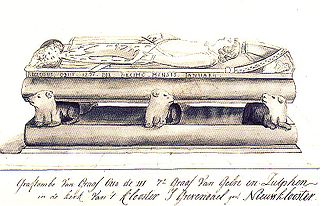
Otto II, Count of Guelders was a nobleman from the 13th century. He was the son of Gerard III, Count of Guelders and Margaretha of Brabant.

Tongelaar Castle is located between Mill and Gassel in North-Brabant, Netherlands.
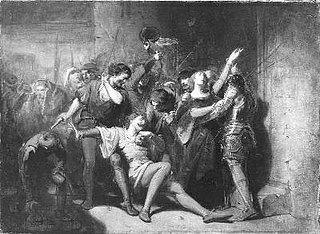
Wolfert I van Borselen was lord of Zandenburg and regent for John I, Count of Holland.

















